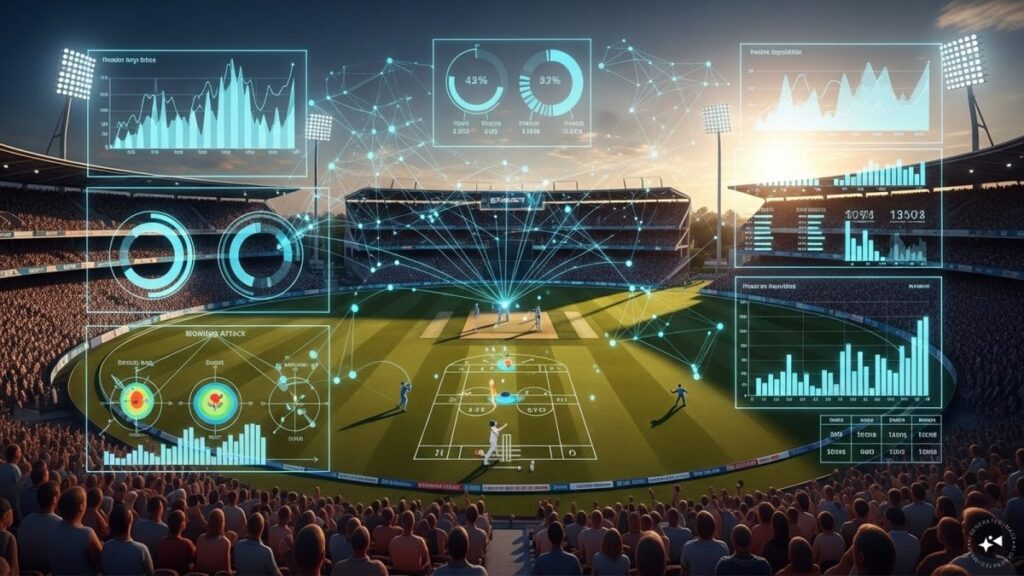Last Updated:
CricViz India’s Subhayu Roy on how cricket data analytics shapes team strategy, talent scouting and blends technology with intuition.
The use of data in cricket has grown manifold over the past decade. From the naked eye being the sole determinant of an individual’s cricketing talent to teams using varied data for the same, cricket has come a long way in using technology to its optimum to bring the best out of athletes.
Cricket data and analytics focus on collecting, cleaning and analysing information to generate insights that guide strategic decisions for teams, cricketers and media. Its key applications include optimising team lineups, studying opposition weaknesses and monitoring player performance.
On the sidelines of the Sportstar–KPMG Playcom Business of Sports Summit 2025, News18 CricketNext caught up with Subhayu Roy, Director, CricViz India, to discuss the growing importance of data in cricket, how analytics differ across formats and teams and whether technology could ever overshadow the traditional ability to spot raw talent.
How do you differentiate between the era when data was not used in cricket and the present situation?
It began with enthusiasts collecting data as a hobby and trying to share it with coaches. The typical response back then was, “I already know this, I do not need numbers to tell me.” Over time, some coaches began to see value in data, not as a replacement for their judgment, but as a tool for validation.
Eventually, it reached a stage where someone like Rahul Dravid involved data scientists in the Indian team’s coaching setup. Today, whether it is the ECB or Cricket Australia, data scientists are integral to team meetings. For instance, if Australia is preparing to face Jasprit Bumrah, they want to know his bowling patterns, strengths and possible tactics.
Ten years ago, this was “nice to know.” Now, it is essential. That is the transformation we have witnessed.
What is the difference between using and analysing data for an IPL team vs a national team?
The core value remains the same, helping teams gain insights and make better decisions. But the challenges differ. Sports, at their heart, are about human achievement, not just numbers. Bazball, for example, is more about Brendon McCullum’s belief in a style of play than pure data.
For New Zealand, the challenge is scarcity; they have a smaller talent pool, so data is crucial for maximising and identifying talent. For India, it is the opposite: a problem of plenty. Data helps ensure no promising cricketer is overlooked in such a vast system. Ultimately, whether it is a franchise or a national team, the goal is the same: extracting marginal gains by better understanding athletes and the game.
As an analytics expert, what is the most basic data you provide to teams?
At the most basic level, we provide what anyone can access: a scorecard. In New Zealand, for example, our data powers the LED scoreboards even at regional matches. Where it becomes different is in the depth of analysis. For instance, measuring the release height of a bowler and correlating it with a batter’s performance.
We might say Rishabh Pant does better when the ball is released above a certain height, making him more effective against someone like Marco Jansen. The true value lies in insight and storytelling, not just raw numbers. For broadcasters, it is about narrative; for teams, it is about actionable insights.
But everything depends on accuracy. Errors in tagging, like misclassifying a delivery, may not matter in isolation but can distort trends over time. At Cricviz, our strength lies in robust training to ensure 100% accuracy. Once data is accurate, the real work is in querying, aggregating and finding stories within it.
When scouting players who have not played much domestic cricket, how challenging does your job become?
Extremely difficult, almost impossible unless by chance. But this is changing. More boards are introducing structured data collection at junior levels. For example, the West Indies now tracks under-15 matches with the same rigour as international games. While that may not immediately impact coaching, it builds a long-term database.
In the future, this will allow teams to run detailed queries, like finding a right-arm pacer who consistently lands five of six balls on a good length. Football already has such global scouting platforms, where managers can filter players by specific metrics. Cricket has been fragmented, but with big data now seen as a solution rather than a burden, we are moving toward building those structures at the grassroots.
Do you think analytics will ever replace the ability of coaches or scouts to spot talent with the naked eye?
Never. The sweet spot is in combining both. At Cricviz, we have two approaches: analysts with cricketing intuition who validate their instincts through data and data scientists who let patterns emerge purely from numbers. When both converge, the insight is powerful.
Data also removes two key risks. First, vested interest: a coach who has trained a player may be biased, even unconsciously, in favour of them. Data adds objectivity. Second, scalability: no human can watch millions of potential players, but data can create benchmarks that equalise subjective opinions.
So, while human judgment will always remain, data ensures that decisions are more balanced, validated and consistent.
September 13, 2025, 15:51 IST
Read More
The postCricket Analytics: Numbers Don’t Tell The Whole Story, Game Still Needs Intuition | Cricket News appeared first on News18

